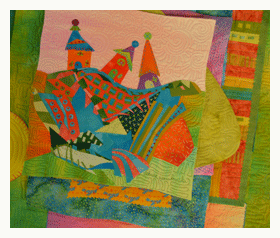9 Expert Fusing Tips for Quilt and Fabric Art – Quilting Daily

A lot of contemporary art quilters swear by fusing their fabric art. But if you’ve had a bad experience with fusing, maybe you just swear.
Although fusing is a fairly straightforward method of applying fabric shapes and appliques to quilts and other fiber art, there are tricks to using it.
If you really want expert advice on how to fuse fabrics, you can do no better than to seek out members of The Chicago School of Fusing, a group of art quilters dedicated to spreading the message of the wonders of fused quilts. Two of the members, Laura Wasilowski and Frieda Anderson, have teamed up to for a Quilting Arts WorkshopTM video, Improvisational Fused Quilt Art, and they spend a whole segment of the workshop on fusing basics.
Laura and Frieda are friends and both are known for their vibrant and often whimsical art quilts that feature fused fabric collage techniques. It’s so much fun to watch them: they practically finish each other’s sentences and their joy in creating is infectious.
Here are some of their tips and tricks for using fusible web:
1. If you’re using a paper-backed fusible, the rough side is the side with the glue. Lay the rough side onto the back of your fabric.

2. Use a hot, dry iron (the cotton setting) and cover the fusible with a piece of the release paper that comes with your fusible, or, use a piece of baking parchment. This will protect your iron from the glue.
3. Don’t over-fuse; the excessive heat will cause the glue to harden and make the fabric stiff.
4. After the fusible has cooled, use a rotary cutter to trim off any excess fabric that hasn’t been covered with fusible. This way, you won’t end up with any partially fused piece of fabric.
5. To separate the backing sheet from the fused fabric, use what Laura calls the squirrel and swipe method. With your hand flat, burrow your fingertips forward between the (the squirrel part). Go a little way in, then swipe your hand side to side once each way quickly to release the outer edges of the paper. Squirrel in a little more, then swipe again. This will help release the paper whole, so you can use it again for protecting your iron, transferring motif shapes, etc.

6. Laura and Frieda prefer to use hand-dyed fabrics as well as batiks, silks, and other fabrics where the color goes all the way through to the back. If you fuse using printed fabrics, the white color from the back of the fabric can often be seen on the cut edge.
7. Wash commercial fabrics before fusing to remove the sizing and starch. If you don’t, the fusible won’t adhere as well to the fabric.
8. Especially on light-colored fabrics, it can be hard to tell which side has the fused glue. To check, place your cut piece of fused fabric between a folded piece of release paper or parchment and tack lightly in one spot with a hot iron. The side the parchment sticks to has the glue.
9. Practice random acts of fusing. Save your fused fabric scraps and leftover cutouts and used them to create a fabric collage on a fabric postcard, in fabric crafts, or on the back of a quilt. This is a great way to practice your design skills and use up your scraps.
Whether you’ve never fused fiber art before or you are an experienced fuser, I can think of no better teachers to take you to the next level of fused textile art than Laura and Frieda. Improvisational Fused Quilt Art: Create Beautiful Art Quilts the Easy Way is now available for fusing and fabric art fun.
P.S. Do you fuse? What is your best tip? If you don’t fuse, why not? Leave your comment below.






Join the Conversation!